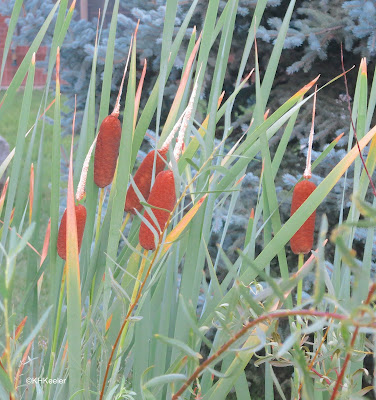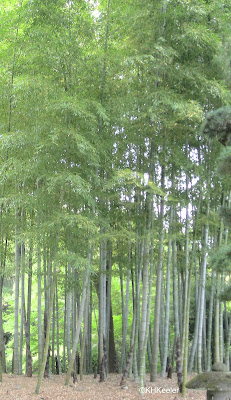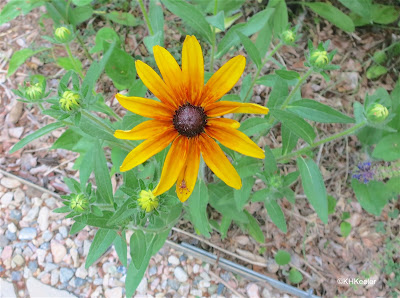Turmeric (
Curcuma longa, ginger family Zingiberaceae) is a Southeast Asian ginger that has been a major spice and dye since antiquity.
 |
| turmeric (Curcuma longa) |
It grows from a rhizome (the source of the spice), with short stems and tall leaves that can be 3' high. Flowers are yellow-white and pretty (
link). While close relatives, called curcuma by nurseries, for example
Curcuma petiolata and
C. aromatica, are grown for their dramatic flowers, breeders have produced some handsome varieties of turmeric as well, with red, white, or pink flowers
link. Turmeric is unknown in the wild and makes no seeds, so it requires people to spread it, although in a few places in the tropics it appears to have escaped from cultivation.
Turmeric has been cultivated in India for at least 4,500 years. It is an important spice in India and Southeast Asia, essential to curry powder, the yellow of yellow rice, and as a medicine and cleanser. It is recorded from the Middle East by 800 BCE, China about 700 CE, and East Africa about 800 CE. It reached the coast of southeast Asia before the Micronesians and Polynesians set sail into the east, so arrived in Tahiti, Hawaii and Easter Island with humans. It does not grow in Europe (too cold and dry) but was brought there by trade through the Middle East shortly after 1000 CE. Europeans called it Indian saffron or eastern saffron, but, lacking a dish like curry in their cuisine, it never became a major spice. Today turmeric is of course essential to curries, and flavors dishes in cuisines from Polynesia to China to India to Iran to west Africa. It is also used commercially as a colorant for lots of foods that are yellowish, from cheese and butter to orange juice and popcorn.
Turmeric is often compared to saffron. Saffron (
Crocus sativus, amaryllis family Amaryllidaceae) makes an intense yellow powdery dyestuff, but, because it is the dried, crushed stigmas of the
flower--small and only available when the plants are flowering--dyes similar to it but available in larger quantities were prized in the Middle East and Europe. Turmeric was valued in its own right, but it also substituted for saffron. For millennia unscrupulous merchants have sold turmeric for saffron. Saffron is native to the eastern Mediterranean, and was not recorded from India before the 10th century, so in India and eastward, saffron is imitation turmeric.
I learned to pronounce turmeric with the first r silent (like February). The first online dictionary I checked pronounced that r, the second said either pronunciation was okay, the Oxford English Dictionary (OED) has it silent (phonetically ˈtəːmərɪk"). I conclude either pronunciation is okay.
I expected the name turmeric to be a version of a Sanskrit name, but the OED shows a whole list of variant English spellings. including tarmaret, tormarith, turn-merick, tarmanick, tarmaluk, and turmerick, and says the origin is from the French terre mérite and Latin terra merita "deserving or deserved earth,", reportedly the name used by early Arab traders. Why it should be "deserved earth" the OED does not say. However, in India, turmeric was sacred to the earth goddess, so perhaps the trade name reflected that.
The scientific name Curcuma is based on the Persian word for saffron kurcum "yellow" which became curcuma in Latin. There are 100 other species of Curcuma, native to tropical Asia. The species epithet for turmeric, longa, simply means long. (Curcuma domestica is an older, now replaced, name for C. longa.)
Turmeric has vast religious significance in Hinduism (see more
link and the Sopher paper listed below). In parts of India, a marriage was completed if the couple linked hands and turmeric water was poured over their hands. That was just one of many ceremonial uses. Turmeric's bright yellow color represented the sun and sun gods but its yellow also matched the yellow of many soils in the region, linking it to earth goddesses, fertility, and prosperity. In an alkaline solution, turmeric turns reddish and as such was symbolic of blood, with all blood's complex associations. Few Hindu ceremonies could be completed without turmeric. I cannot think of a western European or American herb given a similar level of significance, for example by itself consecrating marriage.
 |
| powdered, commercial turmeric |
Turmeric is widely used in Ayurdevic medicine and traditional Chinese medicine. It is antiseptic, antibacterial, and anti-inflammatory, with little toxicity (though it not recommended for people with bile duct obstructions and gallstones). German Commission E, testing traditional medicines with modern science, found it effective for digestive complaints and as a tonic. It reduces hay-fever symptoms, cholesterol and more (see WebMD,
link).
Today, it is grown all across the tropics, with much more of that produced is used locally than is exported. Most tropical cuisines use it. It provides the color of yellow rice, often today colored with saffron but originally and traditionally made with turmeric. Though Europe barely noticed it, turmeric has been a very important spice for a very long time.
Turmeric also produces an intense yellow dye: about that in the next post. Turmeric Part 2.
Comments and corrections welcome.
Sources
Alexander, R. 2018.
What Is the Meaning of Turmeric in Hinduism? Classroom.com link
Blumenthal, M., A. Goldberg and J. Brinckman. 2000. Herbal Medicine. Expanded Commission E Monographs. American Botanical Council, Austin, TX.
Crohn-Ching, V. F. 1980. Hawaii Dye Plants and Dye Recipes. University of Hawaii Press, Honolulu.
Patnaik, N. 1993. The Garden of Life. An Introductino to the Healing Plants of India. Doubleday, New York.
Prabhakaran Nair, K. P. 2013. The Botany of Turmeric. The Agronomy and Economy of Turmeric and Ginger. online at Science Direct
link (Accessed 5/27/20)
Prasad, S. and B. B. Agrawal. 2011. Turmeric, the Golden Spice.
Herbal Medicine: Biomolecular and Clinical Aspects. 2nd edition. NCBI, NIH (National Institutes of Health) link (Accessed 5/27/20)
Sopher, D. E. 1964. Indigenous uses of turmeric (
Curcuma domestica) in Asia and Oceania. Anthropos. 59 (1/2): 93-127.
Swahn, J. O. 1991. The Lore of Spices. Crescent Books, Gothenburg, Sweden.
Kathy Keeler, A Wandering Botanist

















































